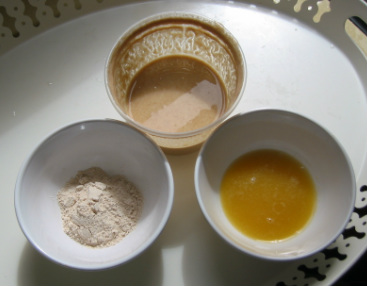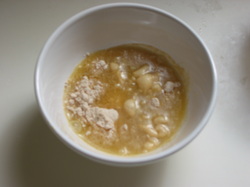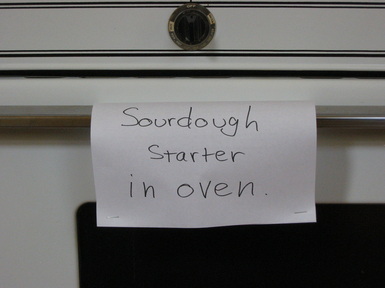
Baby sourdough starter with whole wheat flour & pineapple juice.
In my quest for health and nourishment, I've come to the point where I've decided to try baking my own sourdough bread. Why? Not because I live in the land for which Lactobacillus sanfranciscensis is named, but because sourdough is healthier for you! Who knew?
For those of you who are not familiar with the food science behind the Paleo diet and nourishing traditions movements, I will explain briefly. Grains contain a substance called phytic acid which is considered to be an antinutrient because it prevents you from absorbing important minerals such as calcium, magnesium, iron, and zinc. Phytic acid content in food can be decreased by fermentation, soaking in acidic solution, and sprouting. People who eat Paleo/Primal Diets have decided to swear off all grains and legumes. People who don't want to abandon beans and cereal go the Nourishing Traditions route and soak/ferment/sprout their food.
I've decided I am not going to give up on lovely things like oatmeal, rice, beans, bread, and tortillas. I'm Mexican, damn it! That leaves me the soaking/fermenting route. After noticing my loaf of megamart bread happily sit on the pantry shelf for weeks without any ill effects I took a closer look at the ingredient list. Eek! Monoglycerides, calcium propionate, calcium sulfate, DATEM... and this is on top of 3 different sources of sugar. Time to bake my own bread.
It turns out that you don't have to soak your flour in crazy stuff (kefir, buttermilk, whey, apple cider vinegar, or lemon juice) to make it more digestible. In fact, soaking your grains/flours in dairy doesn't help at all. The calcium in dairy inhibits phytic acid breakdown. See here for more info. What to do? Sourdough baking is a well established, non-weird process that also happens to reduce the phytic acid content of flour. Much heartened, I looked around for information on making my own starter and found The Pineapple Juice Solution (not to be confused with the 7 percent solution). There are several other places online with directions for this starter, like here and here. They all use different proportions and timing. At first this was confusing, but then I took it to mean that this process is very forgiving and pretty hard to screw up.
I bought a jar of organic pineapple juice, and a couple scoops of organic stone ground whole wheat bread flour from the bulk bins at my local hippy coop store. I couldn't wait to start my project, so I grabbed a pint tub from my Honey's cupboard and stirred the ingredients together at his house. The directions I tried to follow are located here. The trouble I ran into was how to measure the flour. I recently learned that you are supposed to gently spoon your flour into the measuring cup then level it off with a butter knife. How do you do that with tablespoons? Are you supposed to spoon the flour into the spoons? Is that too meta? I ended up with too much flour in proportion to the pineapple juice and got a paste instead of the slurry shown in the video. That's when I turned to the interwebs for more information and found all the other directions that I listed above. Encouraged by the level of variation I added more juice to my paste until it became a slurry and left the pint tub on top of the fridge. Every 8 or 12 hours I gave it a stir, or a shake.
Predictably, the first 48 hours nothing happened, except that my new pet took a trip out to my brother's house for a visit. My brother suggested we name it and we spent some time looking up deities associated with baking, brewing, and fermentation. Silenus... Aegir... Tezcatzontecatl... ain't that a mouthful? While I got distracted watching The Amazing Race my bro carefully taped a tiny note to the tub reading "Ninkasi Mbaba" after the Sumerian and Zulu godesses. Sure, why not? It's too cute and sweet for me to resist. Have I mentioned this is my older brother?
Today my new pet reached the 48 hour mark, so I measured out two tablespoons of flour and 2 tablespoons of pineapple juice. The juice was cold, so I added a tablespoon of warm water to try to bring it up to temperature.
For those of you who are not familiar with the food science behind the Paleo diet and nourishing traditions movements, I will explain briefly. Grains contain a substance called phytic acid which is considered to be an antinutrient because it prevents you from absorbing important minerals such as calcium, magnesium, iron, and zinc. Phytic acid content in food can be decreased by fermentation, soaking in acidic solution, and sprouting. People who eat Paleo/Primal Diets have decided to swear off all grains and legumes. People who don't want to abandon beans and cereal go the Nourishing Traditions route and soak/ferment/sprout their food.
I've decided I am not going to give up on lovely things like oatmeal, rice, beans, bread, and tortillas. I'm Mexican, damn it! That leaves me the soaking/fermenting route. After noticing my loaf of megamart bread happily sit on the pantry shelf for weeks without any ill effects I took a closer look at the ingredient list. Eek! Monoglycerides, calcium propionate, calcium sulfate, DATEM... and this is on top of 3 different sources of sugar. Time to bake my own bread.
It turns out that you don't have to soak your flour in crazy stuff (kefir, buttermilk, whey, apple cider vinegar, or lemon juice) to make it more digestible. In fact, soaking your grains/flours in dairy doesn't help at all. The calcium in dairy inhibits phytic acid breakdown. See here for more info. What to do? Sourdough baking is a well established, non-weird process that also happens to reduce the phytic acid content of flour. Much heartened, I looked around for information on making my own starter and found The Pineapple Juice Solution (not to be confused with the 7 percent solution). There are several other places online with directions for this starter, like here and here. They all use different proportions and timing. At first this was confusing, but then I took it to mean that this process is very forgiving and pretty hard to screw up.
I bought a jar of organic pineapple juice, and a couple scoops of organic stone ground whole wheat bread flour from the bulk bins at my local hippy coop store. I couldn't wait to start my project, so I grabbed a pint tub from my Honey's cupboard and stirred the ingredients together at his house. The directions I tried to follow are located here. The trouble I ran into was how to measure the flour. I recently learned that you are supposed to gently spoon your flour into the measuring cup then level it off with a butter knife. How do you do that with tablespoons? Are you supposed to spoon the flour into the spoons? Is that too meta? I ended up with too much flour in proportion to the pineapple juice and got a paste instead of the slurry shown in the video. That's when I turned to the interwebs for more information and found all the other directions that I listed above. Encouraged by the level of variation I added more juice to my paste until it became a slurry and left the pint tub on top of the fridge. Every 8 or 12 hours I gave it a stir, or a shake.
Predictably, the first 48 hours nothing happened, except that my new pet took a trip out to my brother's house for a visit. My brother suggested we name it and we spent some time looking up deities associated with baking, brewing, and fermentation. Silenus... Aegir... Tezcatzontecatl... ain't that a mouthful? While I got distracted watching The Amazing Race my bro carefully taped a tiny note to the tub reading "Ninkasi Mbaba" after the Sumerian and Zulu godesses. Sure, why not? It's too cute and sweet for me to resist. Have I mentioned this is my older brother?
Today my new pet reached the 48 hour mark, so I measured out two tablespoons of flour and 2 tablespoons of pineapple juice. The juice was cold, so I added a tablespoon of warm water to try to bring it up to temperature.

Juice poured on flour.
The purpose of stirring the starter is to introduce oxygen into the mix for the yeast to be able to multiply, so I beat the mixture like eggs for omelettes. Hey, if something is worth doing, it's worth overdoing. I tucked it into the oven with the light on. Several hours later I took a peek and the lid had become distended with gas! There still are no bubbles, but it looks like my little pet is waking up. Hopefully, next week I'll be baking my first whole wheat boule.


 RSS Feed
RSS Feed